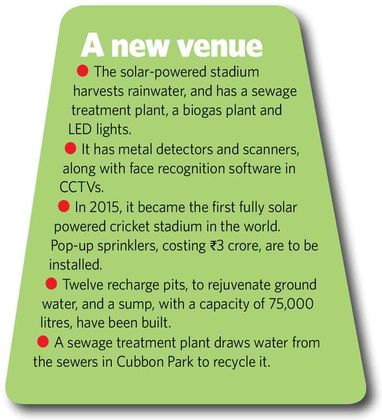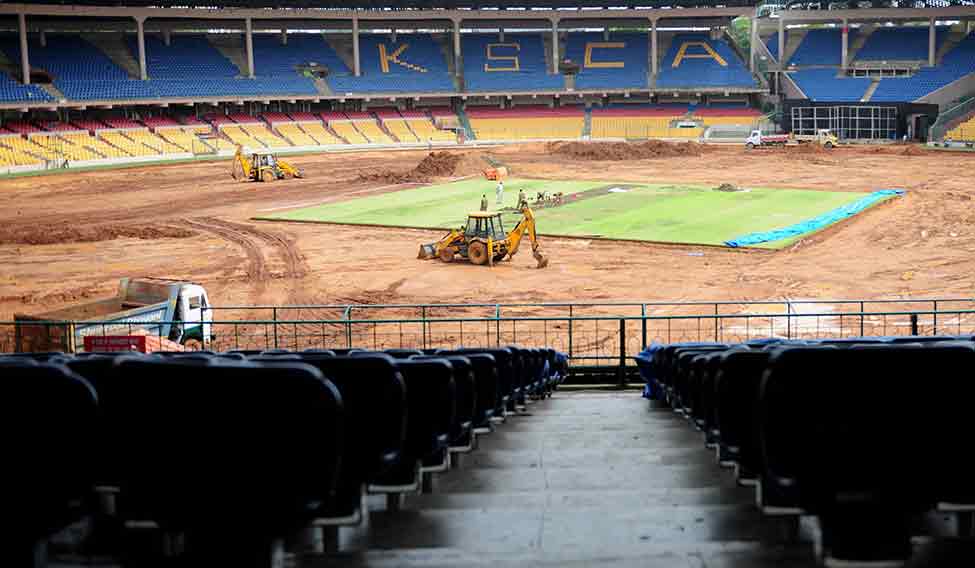In May, Indian Premier League matches were moved out of drought-hit Maharashtra on Bombay High Court orders. The court said the water that went into the preparation of cricket grounds could better quench the thirst of several water-starved districts in the state, and described the Board of Control for Cricket in India as “insensitive”.
Battling perceptions of elitism, the cricket establishment seems to be turning over a new, green leaf. And, leading the way is the M. Chinnaswamy Stadium owned by the Karnataka State Cricket Association in Bengaluru.
Said KSCA secretary Brijesh Patel: “Our stadium has bagged the [BCCI] best pitch and ground award for the second time. We have a social obligation to go green, too.”
The stadium harvests rainwater and has a sewage treatment plant, a biogas plant and LED lights. It was built in 1969 and, in 2015, became the first fully solar powered cricket stadium in the world. It was inspired by Germany’s Freiburg football stadium. The 400KW solar plant at the stadium cost Rs 4.5 crore and, in six months, the stadium will have several green features, including more solar panels.

Said Patel: “Annually, the stadium consumes 18 lakh units of power costing about Rs 1.2 crore. The solar panels on the eastern stands alone generate 1,700 units daily. Once the project is completed, it will not just cut down 600 tonnes of carbon emissions, but also earn a revenue of Rs 80 lakh by selling excess power to the Bangalore Electricity Supply Company.”
Said Santosh Menon, assistant secretary (cricket) of KSCA: “The stadium was solar-ready in 50 days, in time for IPL season eight. The power generated through solar panels can light up 200 houses throughout the year. Efficient LED lights have replaced the halogen lamps along the boundary wall.”
As part of the ongoing work, the intermediate layer of soil, laid in 1968, will be replaced with a sand base. Pop-up sprinklers, costing Rs 3 crore, will also be installed. The latest innovation is the SubAir System, a US technology used in the National Football League and the FIFA World Cup, which can minimise match delays because of rain.
Earlier, after rain, the groundsmen struggled to drain out excess water with Super Soppers from the boundary line. It took 100 people and 45 minutes to ready the pitch after each downpour.

The SubAir System consists of a vault, which has a blower with two modes—vacuum and pressure—and is connected to the existing pipe network. When it rains, the blower, in vacuum mode, pulls water and air from the surface into the drainage pipes. The water drains off into a storage unit, and the air is collected in the vault. In pressure mode, the system releases the stored air up towards the surface, which helps dry the field.
“The grass remains green as the system pumps oxygen underneath the soil,” said ground curator K. Sriram. “The match can resume within five minutes after the rain stops as water is drained out and diverted to the storage or the borewell recharge points in the stadium.” The BCCI plans to introduce the SubAir System in all its venues.
The delightfully green stadium, however, comes at a price. KSCA consumes 56,667 litres of water a day (17 lakh litres a month) and, during matches, the daily demand goes up to 70,000 litres a day (21 lakh litres a month). But, the heavy downpour has turned into a blessing as the KSCA harvests rainwater through its rooftop and ground. Twelve recharge pits, to rejuvenate ground water, and a sump, with a capacity of 75,000 litres, have been built.
“A sewage treatment plant (with a capacity of two lakh litres, and built at Rs 85 lakh) draws water from the sewers in Cubbon Park to recycle it into tertiary level (potable). This has slashed the water bill,” said Patel.
The stadium—with the sprawling Cubbon Park on one side and the plush M.G. Road on the other—has been the venue of many big matches, including the IPL and Champions League Twenty20 finals this year. After two low-intensity bomb blasts at the stadium in April 2010, the KSCA installed metal detectors and scanners, along with face recognition software in CCTVs, to improve surveillance. With its many firsts, the stadium, which seats 34,000, has been a trendsetter.







